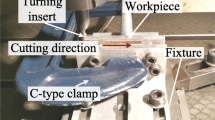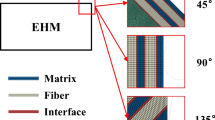Abstract
Medium density fiberboard (MDF) is a commonly used engineered wood product. Sawing is a key process in MDF usage. In this study, a Johnson–Cook constitutive model for two types of MDF under high-speed impact was developed, and a simulation model for the circular sawing process that calculates cutting forces under different process parameters was created. The accuracy of the simulation model was verified through sawing experiments and the effects of cutting speed, feed per tooth, and saw blade position on cutting force and surface roughness were analyzed. The results indicate that MDF prepared with poly 4,4′-diphenylmethane diisocyanate (pMDI) has better mechanical properties than MDF made with urea–formaldehyde (UF) resin, leading to greater cutting force and surface roughness during processing. The cutting surface roughness and cutting force are positively correlated with the cutting speed and feed per tooth, and the excessive cutting speed leads to the cutting system’s vibration, which makes them increase more obviously. Increase the distance between the rotation axis of the saw blade and the workpiece results in more sawteeth participating in the cutting process, which increases the cutting force but also reduces the axial force fluctuation and the surface roughness.












Similar content being viewed by others
References
Aguilera A (2011) Cutting energy and surface roughness in medium density fiberboard rip sawing. Eur J Wood Prod 69:11–18. https://doi.org/10.1007/s00107-009-0396-z
Bort CMG, Bosetti P, Bruschi S (2011) Modelling sawing of metal tubes through FEM simulation. AIP Conf Proc 1353:651–656. https://doi.org/10.1063/1.3589589
Bragov AM, Konstantinov AY, Lamzin DA, Lomunov AK, Gonov ME (2020) Determination of the mechanical properties of concrete using the split Hopkinson pressure bar method. Proc Struct Integr 28:2174–2180. https://doi.org/10.1016/j.prostr.2020.11.045
Costes JP, Decès-Petit C, Altintas Y, Ko P (2003) Estimated stress and friction distributions on tool rake face in the medium density fiberboard cutting process. Forest Prod J 138:468–471
Darmawan W, Rahayu I, Nandika D, Marchal R (2012) The importance of extractives and abrasives in wood materials on the wearing of cutting tools. BioResources 7(4):4715–4729. https://doi.org/10.5552/drind.2012.1207
Dippon J, Ren H, Amara FB, Altintas Y (2000) Orthogonal cutting mechanics of medium density fiberboards. Forest pro J 50:25–30. https://doi.org/10.1023/A:1009277009836
Domínguez-Robles J, Tarrés Q, Alcalà M, El Mansouri N-E, Rodríguez A, Mutjé P, Delgado-Aguilar M (2020) Development of high-performance binderless fiberboards from wheat straw residue. Constr Build Mater 232:117247. https://doi.org/10.1016/j.conbuildmat.2019.117247
Ekevad M, Cristovao L, Marklund B (2012) Lateral cutting forces for different tooth geometries and cutting directions. Wood Mater Sci Eng 7:126–133. https://doi.org/10.1080/17480272.2012.662699
Fekiac J, Svoren J, Gaborik J, Nemec M (2022) Reducing the energy consumption of circular saws in the cutting process of plywood. Coatings 12:55. https://doi.org/10.3390/coatings12010055
Guan C, Liu J, Zhang H, Wang X, Zhou L (2019) Evaluation of modulus of elasticity and modulus of rupture of full-size wood composite panels supported on two nodal-lines using a vibration technique. Constr Build Mater 218:64–72. https://doi.org/10.1016/j.conbuildmat.2019.05.086
Kminiak R, Gaff M (2015) Roughness of surface created by transversal sawing of spruce, beech, and oak wood. BioResources 10(2):2873–2887. https://doi.org/10.15376/biores.10.2.2873-2887
Kojima Y, Nakata S, Suzuki S (2010) The durability of diphenylmethane diisocyanate- and phenol-formaldehyde-bonded Japanese cypress particleboard. Forest Prod J 60:282–288. https://doi.org/10.13073/0015-7473-60.3.282
Kowaluk G, Szymanski W, Palubicki B, Beer P (2009) Examination of tools of different materials edge geometry for MDF milling. Eur J Wood Prod 67:173–176. https://doi.org/10.1007/s00107-008-0302-0
Krzyżaniak Ł, Smardzewski J (2021) Impact damage response of L-type corner joints connected with new innovative furniture fasteners in wood-based composites panels. Compos Struct 255:113008. https://doi.org/10.1016/j.compstruct.2020.113008
Langdon GS, Gabriel S, von Klemperer CJ, Yuen SCK (2021) Transient response and failure of medium density fibreboard panels subjected to air-blast loading. Compos Struct 273:114253. https://doi.org/10.1016/j.compstruct.2021.114253
Lee TC, Mohd Pu’ad NAS, Selimin MA, Manap N, Abdullah HZ, Idris MI (2020) An overview on development of environmental friendly medium density fibreboard. Mater Today Proc 29:52–57. https://doi.org/10.1016/j.matpr.2020.05.679
Li R, Xu W, Wang X, Wang C (2018a) Modeling and predicting of the color changes of wood surface during CO2 laser modification. J Clean Prod 183:818–823. https://doi.org/10.1016/j.jclepro.2018.02.194
Li W, Zhang Z, Luo B (2018b) Effects of sawtooth side edges with different radial clearance angles on the cutting force in wood sawing. Materialwiss Werkstofftech 49:1468–1475. https://doi.org/10.1002/mawe.20180007
Licow R, Chuchala D, Deja M, Orlowski KA, Taube P (2020) Effect of pine impregnation and feed speed on sound level and cutting power in wood sawing. J Clean Prod 272:122833. https://doi.org/10.1016/j.jclepro.2020.122833
Lubis MAR, Park B-D, Lee S-M (2017) Modification of urea-formaldehyde resin adhesives with blocked isocyanates using sodium bisulfite. Int J Adhes Adhes 73:118–124. https://doi.org/10.1016/j.ijadhadh.2016.12.001
Luo B, Li L, Liu H, Wang M, Xu M, Xing F (2015) Effects of sanding parameters on sanding force and normal force in sanding wood-based panels. Holzforschung 69(2):241–245. https://doi.org/10.1515/hf-2014-0012
Mantanis GI, Athanassiadou ET, Barbu MC, Wijnendaele K (2018) Adhesive systems used in the European particleboard, MDF and OSB industries. Wood Mater Sci Eng 13:104–116. https://doi.org/10.1080/17480272.2017.1396622
Meng Y, Wei J, Wei J, Chen H, Cui Y (2019) An ANSYS/LS-DYNA simulation and experimental study of circular saw blade cutting system of mulberry cutting machine. Comput Electron Agr 157:38–48. https://doi.org/10.1016/j.compag.2018.12.034
Nasir V, Cool J (2020) A review on wood machining: characterization, optimization, and monitoring of the sawing process. Wood Mater Sci Eng 15:1–16. https://doi.org/10.1080/17480272.2018.1465465
Nasir M, Hashim R, Sulaiman O, Nordin NA, Lamaming J, Asim M (2015) Laccase, an emerging tool to fabricate green composites: a review. BioResources 10:6262–6284. https://doi.org/10.15376/biores.10.3.Nasir
Perisse F, Menecier S, Duffour E, Vacher D, Monier G, Destrebecq JF, Czarniak P, Górski J, Wilkowski J (2017) MDF treatment with a Dielectric Barrier Discharge (DBD) torch. Int J Adhes Adhes 79:18–22. https://doi.org/10.1016/j.ijadhadh.2017.09.006
Qi H, Qin S, Cheng Z, Zou Y, Cai D, Wen D (2021) DEM and experimental study on the ultrasonic vibration-assisted abrasive finishing of WC-8Co cemented carbide cutting edge. Powder Technol 378:716–723. https://doi.org/10.1016/j.powtec.2020.10.043
Rofii MN, Yumigeta S, Kojima Y, Suzuki S (2014) Utilization of high-density raw materials for panel production and its performance. Proc Environ Sci 20:315–320. https://doi.org/10.1016/j.proenv.2014.03.039
Ross CA, Thompson PY, Tedesco JW (1989) Split-Hopkinson pressure-bar tests on concrete and mortar in tension and compression. Aci Mater J 86:475–481. https://doi.org/10.14359/2065
Roth CC, Mohr D (2014) Effect of strain rate on ductile fracture initiation in advanced high strength steel sheets: experiments and modeling. Int J Plasticity 56:19–44. https://doi.org/10.1016/j.ijplas.2014.01.003
Shamchi SP, Melo FJMQ, Tavares PJ, Moreira PMGP (2019) Thermomechanical characterization of Alclad AA2024-T3 aluminum alloy using split Hopkinson tension bar. Mech Mater 139:103198. https://doi.org/10.1016/j.mechmat.2019.103198
Song B, Sanborn B (2018) Relationship of compressive stress–strain response of engineering materials obtained at constant engineering and true strain rates. Int J Impact Eng 119:40–44. https://doi.org/10.1016/j.ijimpeng.2018.05.001
Svoren J, Nascak L, Koleda P, Barcik S, Nemec M (2021) The circular saw blade body modification by elastic material layer effecting circular saws sound pressure level when idling and cutting. Appl Acoust 179:108028. https://doi.org/10.1016/j.apacoust.2021.108028
Tang X, Bai Y, Duong A, Smith MT, Li L, Zhang L (2009) Formaldehyde in China: production, consumption, exposure levels, and health effects. Environ Int 35:1210–1224. https://doi.org/10.1016/j.envint.2009.06.002
Teng Y, Ding J, Wang B, Guo X, Cao P (2014) Cutting forces and chip morphology in medium density fiberboard orthogonal cutting. BioResources 9(4):5845–5857
Thibaut B, Denaud L, Collet R, Marchal R, Beauchene J, Mothe F, Meausoone P-J, Martin P, Larricq P, Eyma F (2016) Wood machining with a focus on French research in the last 50 years. Ann Forest Sci 73:163–184. https://doi.org/10.1007/s13595-015-0460-2
Trejo J, Polli ML, Da Rocha MP, Torres A, Belini UL, Ninin P (2020) Working limit of the circular saws in the cutting of high density fiberboard (HDF) through a nonlinear model and differential equations. Eur J Wood Prod 78:1183–1194. https://doi.org/10.1007/s00107-020-01596-9
Trejo J, Tolosa R, Ruiz N, Ninin P, Fuenmayor C, Zambrano M, Palma O, Nunez Y (2021) Comparative study of the main properties associated with thin layers of coatings with the cobalt-chromium-tungsten alloy (stellite) and hard chromium plating used as reinforcements for wood sawing. Mech Mater 152:103637. https://doi.org/10.1016/j.mechmat.2020.103637
Wang Z, Zeng Q, Wan L, Lu Z, Zhou J (2022) Investigation of fragment separation during a circular saw blade cutting rock based on ANSYS/LS-DYNA. Sci Rep 12:17346. https://doi.org/10.1038/s41598-022-22267-0
Wasielewski R, Orlowski KA, Szyszkowski S (2012) Economical wood sawing with circular saw blades of a new design. Drvna Ind 63:27–32. https://doi.org/10.5552/drind.2012.1121
Xiong X, Ma Q, Yuan Y, Wu Z, Zhang M (2020) Current situation and key manufacturing considerations of green furniture in China: a review. J Clean Prod 267:121957. https://doi.org/10.1016/j.jclepro.2020.121957
Xu X, Li Y, Malkin S (2001) Forces and energy in circular sawing and grinding of granite. J Manuf Sci Eng 123(1):13–22. https://doi.org/10.1115/1.1344900
Xu D, Yang L, Zhao M, Zhang J, Syed-Hassan SSA, Sun H, Hu X, Zhang H, Zhang S (2021) Conversion and transformation of N species during pyrolysis of wood-based panels: a review. Environ Pollut 270:116120. https://doi.org/10.1016/j.envpol.2020.116120
Yu M, Wang B, Ji P, Li B, Zhang L, Zhang Q (2023) Study on the dynamic stability of circular saw blade during medium density fiberboard sawing process with thermo-mechanical coupling. Comput Electron Agr 211:108042. https://doi.org/10.1016/j.compag.2023.108042
Zeinali D, Verstockt S, Beji T, Maragkos G, Degroote J, Merci B (2018) Experimental study of corner fires-Part II: flame spread over MDF panels. Combust Flame 189:491–505. https://doi.org/10.1016/j.firesaf.2020.103265
Zeinali D, Vandemoortele E, Verstockt S, Beji T, Maragkos G, Merci B (2021) Experimental study of corner wall fires with one or two combustible walls. Fire Safety J 121:103265. https://doi.org/10.1016/j.combustflame.2017.10.023
Zhang Q, Huang K, Wang J, Wang L, Yuan M, Tian Y, Ouyang L (2021) Effect of pulse electromagnetic coupling treatment on thermal conductivity of WC-8Co cemented carbide. Ceram Int 47:22683–22692. https://doi.org/10.1016/j.ceramint.2021.04.283
Zhang S, Ghosh KR, Yao Z, Li L, Qin A, Qiao W, Wang ZY (2022) Formation of reactive isocyanate group-containing polymers via Lossen rearrangement. Mater Today Commun 30:103169. https://doi.org/10.1016/j.mtcomm.2022.103169
Zhu Y, Zhou Q, Liu B, Li Z (2014) Finite element analysis on interaction between lunar regolith and cutter. Procedia Eng 73:194–203. https://doi.org/10.1016/j.proeng.2014.06.188
Acknowledgements
We gratefully acknowledge the financial support of Fundamental Research Funds for the Central Nonprofit Research Institution of CAF No. CAFYBB2019QB006, and National Natural Science Foundation of China (No. 32171710), and Beijing Natural Science Foundation (No. 3232022).
Author information
Authors and Affiliations
Contributions
MY: Methodology, writing—original draft, investigation, conceptualization. BW: Simulation—review and editing. PJ: Simulation—review and editing. BL: Resources, writing—review and editing. LZ: Writing—review and editing. QZ: Resources, review and editing.
Corresponding author
Ethics declarations
Conflict of interest
The authors declare that they have no known competing financial interests or personal relationships that could have appeared to influence the work reported in this paper.
Additional information
Publisher's Note
Springer Nature remains neutral with regard to jurisdictional claims in published maps and institutional affiliations.
Rights and permissions
Springer Nature or its licensor (e.g. a society or other partner) holds exclusive rights to this article under a publishing agreement with the author(s) or other rightsholder(s); author self-archiving of the accepted manuscript version of this article is solely governed by the terms of such publishing agreement and applicable law.
About this article
Cite this article
Yu, M., Wang, B., Ji, P. et al. Simulation analysis of the circular sawing process of medium density fiberboard (MDF) based on the Johnson–Cook model. Eur. J. Wood Prod. 82, 447–459 (2024). https://doi.org/10.1007/s00107-023-02007-5
Received:
Accepted:
Published:
Issue Date:
DOI: https://doi.org/10.1007/s00107-023-02007-5




